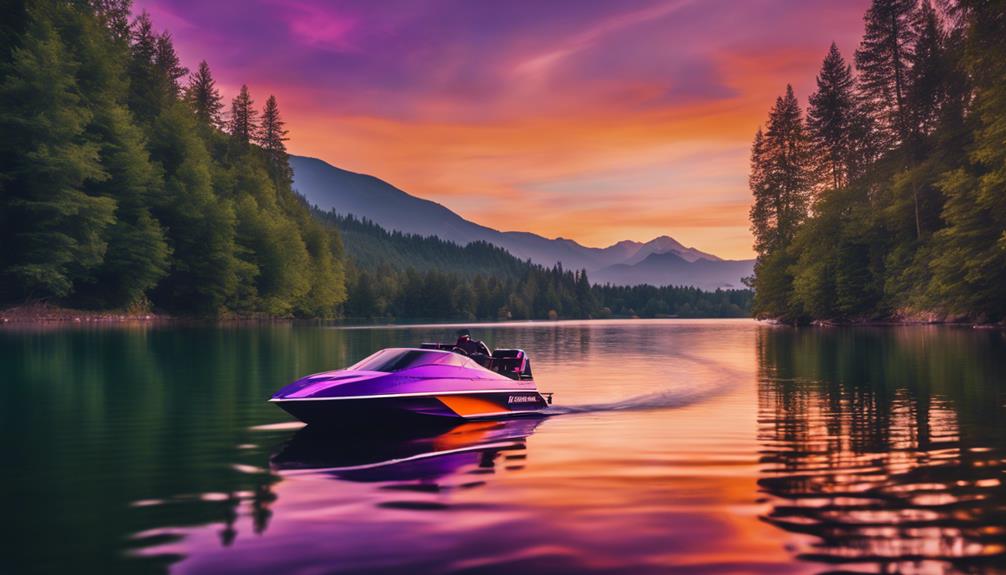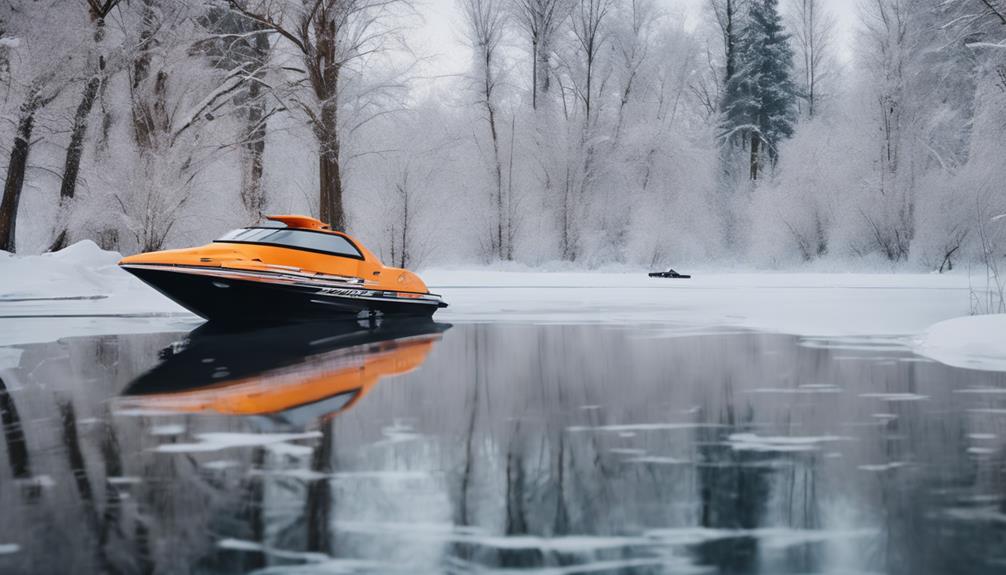Jet boats steer by utilizing directional thrust from a jet pump, giving you quick and agile maneuverability. The jet pump draws water in and expels it through a rear nozzle, while the steering nozzle directs the water jet to change your boat's direction. Innovations like Thrust Vector technology and the Articulating Keel enhance control, especially at low speeds, making tight maneuvers easier. Additionally, reverse control systems and lateral thrusters improve your boat's handling in reverse. With these advanced features, you can navigate confidently through various conditions and challenges. Discover how these systems work together for peak performance!
Key Takeaways
- Jet boats steer using directional thrust from a jet pump that expels water through a rear nozzle to propel and maneuver the vessel.
- The steering nozzle directs the water jet, allowing for quick and responsive changes in direction.
- Innovations like Thrust Vector and Articulating Keel enhance low-speed maneuverability and overall control, improving handling in tight spaces.
- Reverse control systems, such as pivoting buckets and Lateral Thrusters, improve backward maneuverability by redirecting thrust.
Overview of Jet Boat Steering
Jet boat steering relies on the directional thrust generated by a jet pump, allowing you to change direction by simply adjusting the nozzle's angle. This innovative system uses jet pumps to draw in water and expel it through a nozzle at the rear, giving you responsive steering control. The deflector nozzle bends the water flow to the left or right, enabling quick maneuvers, especially at high speeds.
However, traditional jet boat steering systems can struggle with slow-speed maneuverability. To address this, manufacturers have introduced enhancements like the Thrust Vector Slow Speed Steering Enhancement in 2010, which incorporates variable rudders to improve control at lower speeds.
In 2012, Yamaha launched its Thrust Directional Enhancer technology, deflecting water at a 45-degree angle to aid slow-speed handling, though it's still not as effective as the Thrust Vector system.
Advancements continued with Yamaha's Articulating Keel technology in 2015, which aimed to balance slow-speed control with high-speed stability.
These innovations highlight the ongoing evolution of jet boat steering systems, ensuring you can navigate your vessel with confidence and precision.
Directional Thrust Mechanics

Directional thrust mechanics play an essential role in how your boat maneuvers, as the jet pump generates and directs powerful water currents to steer the vessel effectively. When you turn the steering control, it adjusts the angle of the steering nozzle at the rear, influencing the direction of thrust. This relationship between thrust direction and steering is vital for smooth navigation.
Here's a quick overview of how the components work together:
| Component | Function |
|---|---|
| Jet Pump | Draws water in and expels it out |
| Steering Nozzle | Directs the water jet for steering |
| Impeller Size | Affects thrust generation |
| Control Mechanism | Adjusts the steering nozzle angle |
| Thrust Vector | Enhances slow-speed maneuverability |
At low speeds, steering can feel weak; however, systems like Thrust Vector help mimic traditional rudder functionality. Despite this, at high speeds, the jet boat benefits from immediate responsiveness, allowing for rapid turns and adjustments, making it a thrilling experience on the water. Understanding these mechanics can enhance your driving skills and overall enjoyment.
Innovations in Steering Technology

Recent advancements in steering technology have transformed how you control jet boats, making maneuverability at both high and low speeds more intuitive and responsive.
Innovations like JetBoatPilot's Thrust Vector Slow Speed Steering Enhancement, introduced in 2010, allow you to steer with precision at lower speeds, functioning similarly to a traditional rudder. Yamaha followed suit with its Thrust Directional Enhancer in 2012, which deflects water at a 45-degree angle to improve slow-speed control, though it doesn't quite match the effectiveness of the Thrust Vector system.
In 2015, Yamaha introduced Articulating Keel technology, enhancing high-speed stability while still facing challenges in slow-speed maneuverability. The 2017 Lateral Thruster, developed by JetBoatPilot, complements these advancements by enhancing reverse control, redirecting one-third of reverse thrust for greater precision. This synergy with Thrust Vector systems makes steering even more responsive.
Additionally, the competitive landscape shifted in 2017 with new entrants using Sea-Doo propulsion systems featuring pivoting reverse buckets, allowing for improved reverse control.
These innovations in steering technology are reshaping how you navigate jet boats, providing you with unprecedented levels of control and confidence on the water.
Slow-Speed Maneuverability Solutions

When you're steering a jet boat at slow speeds, effective control can be a challenge.
Solutions like Thrust Vector Enhancements and Articulating Keel Technology have emerged to improve your control and maneuverability in these situations.
Let's explore how these innovations can make your slow-speed handling more precise and enjoyable.
Thrust Vector Enhancements
Thrust vector enhancements have transformed slow-speed maneuverability in jet boats, allowing you to navigate tight spaces with ease and confidence. These advanced systems improve your control by redirecting water flow, making it easier to steer in challenging conditions.
Here are some key features that illustrate how thrust vector technology elevates your experience:
- Variable rudder systems that mimic traditional rudders for better steering at low speeds.
- 45-degree water deflection from Yamaha's Thrust Directional Enhancer, providing additional maneuverability.
- Longer rudder designs with the Thrust Vector XL, guaranteeing better contact with undisturbed water.
- Precision control achieved through the combination of Lateral Thruster and Thrust Vector XV, redirecting reverse thrust.
With these thrust vector enhancements, you'll find slow-speed control greatly improved, making every turn smoother and every docking maneuver more precise.
Whether you're threading through narrow channels or backing into a slip, these innovations guarantee you have the best tools at your disposal for exceptional maneuverability.
Articulating Keel Technology
Articulating Keel technology enhances your jet boat's slow-speed maneuverability by allowing the keel to pivot with the steering angle, resulting in more responsive handling. Introduced by Yamaha in 2015, this innovative system improves tracking and directional control, making it easier for you to steer through tight spaces and execute precise maneuvers during docking.
While the articulating keel excels at high-speed stability, it does have limitations in slow-speed control compared to specialized systems like JetBoatPilot's Thrust Vector. However, its design facilitates a smoother shift between slow and high-speed operations, which can be beneficial for larger jet boats where control is paramount.
When you're operating at lower speeds, the articulating keel provides enhanced feedback, allowing you to feel more connected to your jet boat. This responsiveness can make a significant difference during tight turns or while steering through congested areas.
Reverse Control Systems Explained

Reverse control systems in jet boats utilize mechanisms like reverse gates and pivoting buckets to enhance maneuverability and precision while moving backward. These systems are vital for effectively managing jet boat engines in reverse, allowing you to navigate tight spaces with confidence.
Here's what you can expect from reverse control systems:
- Reverse Gates: Redirect water flow, improving backward maneuverability.
- Pivoting Buckets: Increase lateral force, giving you greater control during reverse.
- Yamaha's System: Limited to a 30-degree turn angle, which may restrict tight maneuvers.
- Driver Mindset: Adjusting your approach is essential; steering dynamics differ from traditional boats.
As you adapt to using reverse control, you'll find that mastering these systems transforms your driving experience. Understanding how each component works will greatly improve your ability to maneuver your jet boat, especially when reversing in challenging environments.
Lateral Thruster Development

When you install the Lateral Thruster, you'll find it's straightforward and doesn't demand extensive tools or experience.
This enhancement greatly boosts your steering control, allowing you to maneuver with precision while reversing.
Let's explore how this innovative addition transforms your jet boating experience.
Lateral Thruster Installation Process
Installing the Lateral Thruster on your Yamaha Jet Boat is a straightforward process that enhances your vessel's maneuverability in no time. With minimal tools and experience required, you can boost your boat's performance effortlessly.
Here's what you'll need to get started:
- A basic tool kit, including screwdrivers and wrenches
- The Lateral Thruster unit designed for your specific jet engine
- Installation instructions from JetBoatPilot
- A clean workspace to prevent any debris from interfering
Once you have everything ready, simply follow the step-by-step instructions provided. The Lateral Thruster redirects one-third of your jet engine's reverse thrust, allowing for improved control and confidence while steering, especially in tight spaces.
Plus, it complements existing systems like the Thrust Vector XV for a seamless user experience.
After installation, you'll quickly notice how this upgrade enhances your slow-speed steering capabilities, making it easier to navigate through tricky spots. With the Lateral Thruster in place, you can enjoy your time on the water with newfound ease and precision.
Enhancements to Steering Control
The development of the Lateral Thruster has considerably enhanced steering control for Yamaha Jet Boats, providing you with improved maneuverability and confidence during reverse operations. Introduced as an aftermarket accessory by JetBoatPilot in April 2017, this innovative system redirects one-third of the reverse thrust from your engine, considerably enhancing your boat's precision in low-speed situations.
By complementing the Thrust Vector XV system, the Lateral Thruster addresses traditional jet boat steering limitations, particularly when moving backward. This combination of propulsion systems allows for tighter turns and better handling, even in challenging conditions. You won't need extensive training to master these enhancements; they promote user confidence right from the start.
Set to ship globally in December 2017, the patent-pending Lateral Thrusters are designed for easy installation with minimal tools, making them accessible for every Yamaha Jet Boat owner. As you navigate tight spaces or execute precise maneuvers, the added control will transform your boating experience.
With the Lateral Thruster, steering becomes intuitive, allowing you to fully enjoy the dynamic capabilities of your jet boat.
Impact of Engine Power

Engine power directly influences a jet boat's steering capabilities, making consistent throttle application essential for maintaining control. When you're at the helm, you must understand that the engine's output directly affects how well you can steer. If you cut the throttle, you lose directional control, and the boat will continue straight in its last direction.
Imagine the following scenarios where engine power matters:
- Turning sharply: Increased throttle allows for quick and responsive turns.
- Navigating tight spaces: Throttle helps you maneuver through narrow passages.
- Adjusting speed: Maintaining RPMs guarantees peak steering response.
- Avoiding obstacles: Power gives you the ability to quickly change direction.
When you're idling or at reduced throttle, steering responsiveness diminishes considerably. Higher RPMs provide the thrust needed for effective steering, while lower RPMs hinder your ability to change direction.
Safety Features of Jet Boats

Jet boats come equipped with several safety features designed to protect both passengers and nearby water users. One of the standout features is the spinning blade containment system, which prevents accidental contact with the propeller-like components, making these boats safer for swimmers and others in the vicinity.
Moreover, the propulsion system in jet boats operates efficiently even in shallow waters. This not only minimizes the risk of damaging marine life but also protects the boat's components. You'll find that jet boats maintain propulsion efficiency better than traditional propeller-driven boats, allowing for safer navigation through various water conditions.
The shallow draft design of jet boats lets them operate in minimal water depths, greatly reducing the likelihood of grounding, especially in unpredictable environments. In addition, safety features such as propeller housing and impeller design are specifically engineered to minimize risks associated with watercraft operation.
With these safety measures in place, jet boats offer a reliable and enjoyable experience while ensuring the safety of everyone on board and in the surrounding waters.
Future of Jet Boat Steering

As safety features continue to evolve, the future of jet boat steering looks promising with advancements in smart navigation technologies that enhance both user experience and control. You can expect steering systems to become more intuitive, providing you with greater confidence while maneuvering through challenging waters.
Imagine a future with:
- Yamaha's Articulating Keel that adapts to your speed for improved handling.
- JetBoatPilot's Thrust Vector systems ensuring precision at both high and low speeds.
- Lateral Thrusters giving you aftermarket options for effortless reverse control.
- Electric power steering systems offering a quieter ride and less maintenance.
These innovations will change how you steer your jet boat, making it easier to navigate tight spaces and respond to sudden changes in conditions.
With high pressure steering systems, you'll have the control you need, whether you're cruising or tackling rough waters.
As these technologies develop, jet boat steering won't only become safer but also more enjoyable, allowing you to focus on the thrill of being on the water.
Frequently Asked Questions
How Does Jet Boat Steering Work?
Jet boat steering works by directing water thrust through a nozzle at the rear. You adjust the angle of the jet stream for turning, allowing for quick maneuvers, especially with advanced systems like Thrust Vector.
How Do Jet Drives Steer?
You might think steering's complicated, but it's simple! Jet drives steer by pivoting a nozzle that directs high-speed water. This thrust alters your boat's direction, requiring constant throttle for effective maneuvering and control.
How Does a Boat Steering System Work?
A boat steering system works by using hydraulic pressure or electric signals to control the rudder or motor. You'll enjoy improved maneuverability and comfort, especially in rough waters, with regular maintenance ensuring ideal performance.
Are Jet Boats Hard to Steer?
As the saying goes, "practice makes perfect." Jet boats can be tricky to steer, especially at low speeds. However, with practice and the right technology, you'll find them surprisingly maneuverable and enjoyable to handle.
Is the Steering System of Jet Boats Effective in Handling Rough Waters?
The jet boat rough water performance is highly effective in handling rough waters. The steering system is designed to provide optimal control and stability, allowing the boat to maneuver through challenging conditions with ease. Jet boats are equipped to handle the demands of rough waters, making them a reliable choice for adventurous boaters.
Conclusion
As you glide across shimmering waters, the thrill of jet boat steering comes alive.
With every twist of the wheel, you harness the power of directional thrust, effortlessly cutting through waves like a knife through butter.
Innovations in technology enhance your control, while safety features wrap you in a comforting embrace.
The future promises even more exciting advancements, ensuring your adventures are as exhilarating as they're safe.
So, buckle up and let the journey unfold!










